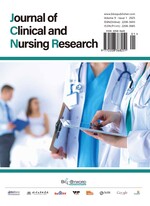Effect of Comprehensive Nursing Intervention on the Maternal and Infant Outcomes of Pregnant Women with Gestational Diabetes Mellitus
Abstract
Objective: To examine the effects of comprehensive nursing interventions on maternal and infant outcomes in pregnant women diagnosed with gestational diabetes mellitus (GDM). Methods: A quasi-experimental design was employed, involving 60 pregnant women with GDM who were purposively selected and randomly allocated into experimental and control groups, each comprising 30 participants. The experimental group received comprehensive nursing interventions and pregnancy monitoring, while the control group received standard nursing care. Data collection was conducted using demographic questionnaires, pregnancy indicators, and maternal-infant outcome measurement tools. The collected data were analyzed using Microsoft Excel and the Statistical Package for Social Sciences (SPSS). Results: The findings indicated significant improvements in fasting blood glucose, postprandial blood glucose, amniotic fluid index, and neonatal birth weight in the experimental group compared to the control group. However, no statistically significant differences were observed in body mass index (BMI) or pregnancy weight gain. Comprehensive nursing interventions were associated with a significant reduction in maternal complications, including polyhydramnios, postpartum hemorrhage, and preeclampsia, as well as neonatal complications such as neonatal pneumonia, macrosomia, and hypoglycemia. Conclusion: Comprehensive nursing interventions have a positive impact on maternal and neonatal outcomes in pregnant women with GDM.
References
Liu CQ, Zeng R, Wu K, 2024, Analysis of the Impact of Personalized Integrated Nursing Intervention on Clinical Effects and Pregnancy Outcomes in Patients with Gestational Diabetes. Diabetes New World, 2024(11): 132–135.
Chuang MT, Liang YL, Chen TS, et al., 2023, Setting Up a Specialized Maternity Unit in a Tertiary Hospital: An Oasis for Pregnant Women with COVID-19 During the Pandemic. Taiwan J Obstet Gynecol, 62(6): 823–829. https://doi.org/10.1016/j.tjog.2023.08.001
Peled T, Sela HY, Weiss A, et al., 2023, Association Between One Abnormal Value on 3-Hour Oral Glucose Tolerance Test and Adverse Perinatal Outcomes in Twin Gestation. Diabetes Res Clin Pract, 202: 110813. https://doi.org/10.1016/j.diabres.2023.110813
Yi YP, 2022, Effect of Comprehensive Nursing Intervention on Blood Glucose Control and Delivery Outcomes in Patients with Gestational Diabetes Mellitus. Diabetes New World, 2022(9): 115–118 + 122.
Ruiz Peláez E, Hurtado Algar EM, Martínez la Torre T, et al., 2024, Impact of the COVID-19 Lockdown on the O’Sullivan Test and Gestational Diabetes Mellitus Diagnosis in Pregnant Spanish Women. Aten Primaria, 56(12): 103006. https://doi.org/10.1016/j.aprim.2024.103006
Xu L, 2021, Effect of Personalized Nursing on Blood Sugar Control and Pregnancy Outcomes in Patients with Gestational Diabetes Mellitus. Chinese Journal of Clinical Rational Drug Use, 14(2): 168–169.
Yu GF, Du Y, 2017, Risk Factors for Gestational Diabetes and Its Impact on Pregnancy Outcomes. Maternal and Child Health Care of China, 32(17): 4071–4072.
Xie C, Li Y, Meng G, et al., 2020, Influencing Factors Related to Complicated Urinary Tract Infection in Cases with Gestational Diabetes Mellitus. Journal of Military Surgeon in Southwest China, 22(6): 514–518.
Lin L, Wu Y, Ma L, 2022, Effects of Radar Chart-Assisted Risk Control Nursing Model on Blood Glucose Control and Pregnancy Outcomes in Patients with Perinatal Gestational Diabetes Mellitus. Diabetes New World, 2022(19): 159–162.
Zhan X, 2022, Effect Observation and Nursing Satisfaction Analysis of Early Nursing Intervention on Patients with Gestational Diabetes Mellitus. Electronic Journal of Practical Gynecological Endocrinology, 9(31): 108–111.
Chen X, Wang C, 2024, Effect of Early Comprehensive Nursing Intervention on Blood Glucose Control in Patients with Gestational Diabetes Mellitus. Electronic Journal of Practical Gynecological Endocrinology, 11(6): 129–131.
Li D, Chen X, Lu Y, 2020, Effect of Comprehensive Nursing Intervention on Blood Sugar Control and Psychological State in Patients with Gestational Diabetes Mellitus. Heilongjiang Medical Journal, 33(4): 963–965.
Lin W, Wen L, Shen H, 2020, Effect of Comprehensive Nursing Intervention on Perinatal Blood Sugar, Complications and Pregnancy Outcomes in Patients with Gestational Diabetes Mellitus. Chinese Manipulation and Rehabilitation Medicine, 11(18): 83–84.
Shekaili HAA, Hashmi IA, Omari OA, 2024, Gestational Weight Gain and Its Association with Maternal and Neonatal Outcomes Among Pregnant Women with Normal Pre-Pregnancy Body Mass Index from a Middle Eastern Country. Midwifery, 130: 103929. https://doi.org/10.1016/j.midw.2024.103929
Wong MMH, Chan MYM, Ng TP, et al., 2024, Impact of Carbohydrate Quantity and Quality on Maternal and Pregnancy Outcomes in Gestational Diabetes Mellitus: A Systematic Review and Meta-Analysis. Diabetes Metab Syndr, 18(1): 102941. https://doi.org/10.1016/j.dsx.2024.102941
Wang X, 2022, Application Effect of Comprehensive Nursing Intervention in Patients with Gestational Diabetes Mellitus Complicated by Gestational Hypertension. Diabetes New World, 2022(11): 115–118 + 128.
Sweeting A, Hannah W, Backman H, et al., 2024, Epidemiology and Management of Gestational Diabetes. Lancet, 404(10448): 175–192. https://doi.org/10.1016/S0140-6736(24)00825-0
Long SQ, 2018, Application of Comprehensive Nursing Intervention in Patients with Neonatal Pneumonia. Jingchu Academic (22nd Issue), 2018: 5.
Liu C, He J, Ma J, et al., 2019, Analysis of the application Value of High Frequency Pulmonary Ultrasound in the Diagnosis of Neonatal Pneumonia. Chinese Journal of Ultrasound in Medicine, 35(5): 405–408.


